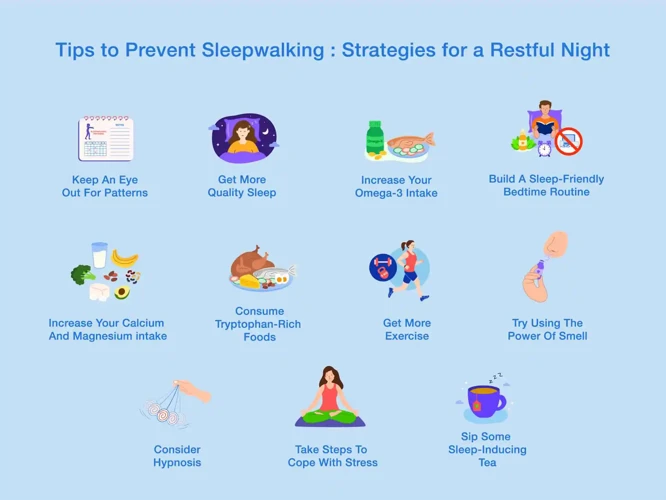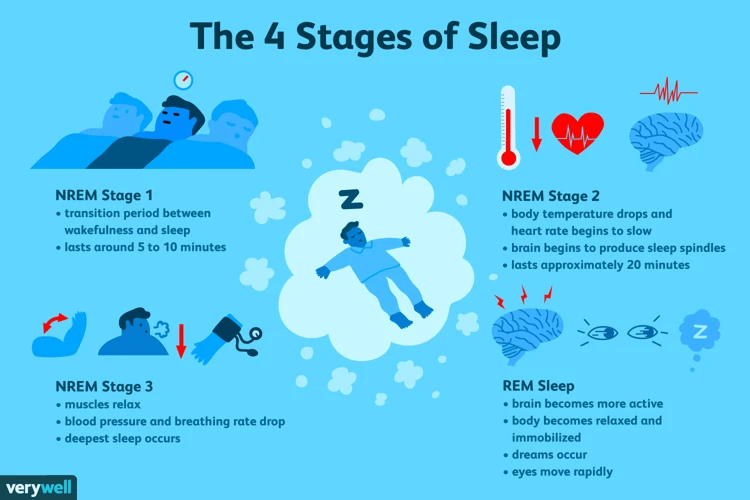Startling Episodes: Famous Sleepwalking Cases in History

Sleepwalking, often referred to as somnambulism, is a fascinating and mysterious sleep disorder that has puzzled both scientists and the general public for centuries. Throughout history, there have been numerous bizarre and extraordinary cases of individuals engaging in complex behaviors while in a state of sleepwalking. From murder trials to strange nocturnal wanderings, these incidents have left many bewildered and seeking answers. In this article, we will delve into the intriguing world of sleepwalking and explore some of the most famous cases that have captivated the attention of the public. Prepare to be amazed and astonished by the peculiarities of the sleeping mind.
Overview of Sleepwalking

Sleepwalking, also known as somnambulism, is a parasomnia disorder characterized by complex behaviors performed during deep sleep. It is more common in children but can also affect adults. During a sleepwalking episode, individuals may sit up in bed, walk around the room, or even leave the house without being aware of their actions. While sleepwalking, people often have a blank or glassy-eyed expression and may appear confused or disoriented. It is important to note that sleepwalkers are not acting out their dreams but are instead in a state of partial wakefulness. Sleepwalking episodes can last anywhere from a few minutes to half an hour or longer. Although the exact cause of sleepwalking remains unclear, various factors such as sleep deprivation, stress, medications, and certain medical conditions may contribute to its occurrence. If you’re curious to learn more about the types of sleepwalking or how it affects children, you can find detailed information about these topics through the provided links.
Famous Cases of Sleepwalking

Over the course of history, there have been several well-documented and intriguing cases of sleepwalking that have captured public attention. One such case is the strange and controversial story of Albert Tirrell, who garnered widespread media coverage during the mid-1800s. Known as the “Sleepwalking Murder Trial,” Tirrell was accused of murdering his lover Maria Bickford while allegedly being in a state of sleepwalking. Another famous sleepwalking incident involves the renowned writer and journalist Ambrose Bierce, who went on a midnight stroll and disappeared mysteriously, never to be seen again. Additionally, the curious case of Kenneth Parks, a Canadian man who drove 14 miles and attacked his in-laws in his sleep, serves as a chilling reminder of the potential dangers associated with sleepwalking. These infamous cases highlight the peculiar and often inexplicable nature of sleepwalking, leaving us questioning the complexities of the human mind during sleep. For more information on the different types of sleepwalking and how it affects children, you can explore the provided link.
1. The Strange Case of Albert Tirrell
One of the most notorious cases of sleepwalking in history is the strange case of Albert Tirrell. Born in London in 1802, Tirrell gained notoriety for his involvement in a peculiar sleepwalking incident that took place in 1845. Tirrell, a respected lawyer, was accused of the murder of his mistress, Maria Bickford. The evidence against him was compelling, with witnesses claiming to have seen Tirrell exit his home and walk towards Bickford’s house on the night of the murder. However, Tirrell’s defense team presented a groundbreaking argument – that he committed the crime while sleepwalking. They argued that he had a long history of sleepwalking episodes and even presented expert testimony to support this claim. The defense claimed that Tirrell was not conscious of his actions at the time of the murder, making him legally innocent. This strategic defense was successful, and Tirrell was ultimately acquitted of the murder charges. The case of Albert Tirrell remains a fascinating example of how sleepwalking can intertwine with the legal system and raise questions about responsibility and culpability. To learn more about different types of sleepwalking or how it affects children, you can explore the provided links.
2. The Midnight Stroll of Ambrose Bierce
Ambrose Bierce, the renowned American writer and journalist, had a particularly fascinating sleepwalking incident that occurred in the late 1800s. One night, while staying at his friend’s house, Bierce experienced a bout of sleepwalking that left everyone perplexed. In the middle of the night, Bierce rose from his bed, fully asleep, and began wandering through the house. What made this incident even more intriguing was the fact that Bierce engaged in a series of complex activities during his nocturnal stroll. Witnesses reported that he opened and closed various doors, rearranged furniture, and even conversed with imaginary people. Despite his seemingly awake state, Bierce had no recollection of the event the next day.
The Midnight Stroll of Ambrose Bierce exemplifies the unpredictable nature of sleepwalking and highlights the extent to which individuals can engage in complex behaviors while asleep. It serves as a testament to the fact that sleepwalking can occur in individuals of all backgrounds and professions, regardless of their level of creativity or intellectual prowess.
If you’re interested in exploring more about different types of sleepwalking, including other intriguing cases like Ambrose Bierce’s, you can find comprehensive information in the provided link.
3. The Curious Incident of Kenneth Parks
One of the most perplexing cases of sleepwalking in history is the curious incident involving Kenneth Parks. In 1987, Parks, a Canadian man, made headlines when he committed a shocking act while seemingly asleep. One night, Parks sleepwalked out of his home, got in his car, and embarked on a bizarre journey. What makes this case even more astonishing is that Parks drove over 14 miles to his in-laws’ house, all while unconscious. Upon arrival, he violently attacked his father-in-law, fatally injuring him, and also assaulted his mother-in-law.
When Parks finally regained consciousness, he was covered in blood, disoriented, and shocked by his actions. He immediately drove himself to a nearby police station to turn himself in, believing he had been involved in a terrible accident. The motive behind Parks’ assault remains a mystery to this day, as he had no known issues with his in-laws and had always been described as a gentle and loving family man.
During his trial, experts testified to the fact that Parks had a history of sleepwalking and had experienced episodes since childhood. The defense argued that Parks had been sleepwalking during the violent incident and was not conscious of his actions. The court ultimately accepted the sleepwalking defense, and Parks was acquitted of the charges of murder and attempted murder.
The case of Kenneth Parks continues to baffle both medical professionals and the public alike. It serves as a stark reminder of the uncontrollable nature of sleepwalking and the potential for individuals to engage in complex and dangerous behaviors while asleep. If you are interested in learning more about the types of sleepwalking or the possible causes behind this mysterious condition, you can find additional information through the provided link.
Common Behaviors During Sleepwalking

Sleepwalking can manifest in a wide range of behaviors, varying from simple to complex actions. While asleep, individuals may engage in activities that they would normally perform during wakefulness. Some common behaviors during sleepwalking include:
- Sitting up in bed: Sleepwalkers may sit up in bed, appearing dazed or confused.
- Walking around: Moving around the bedroom or even venturing into other areas of the house is a typical behavior during sleepwalking episodes.
- Opening doors: Sleepwalkers may attempt to open doors, often without successfully navigating the task due to their unconscious state.
- Talking or mumbling: Sleepwalkers may engage in vocalizations, speaking incoherently or mumbling.
- Grocery shopping or food preparation: In more complex cases, sleepwalkers have been observed engaging in activities like grocery shopping, preparing meals, or eating without any recollection upon waking.
- Driving: While exceptionally rare, there have been instances of sleepwalkers getting behind the wheel and driving, posing a significant danger to themselves and others.
It is important to maintain a safe sleep environment for individuals who sleepwalk to prevent any potential harm. If you would like to learn more about the various types of sleepwalking or how it specifically affects children, feel free to click on the provided link for further information and insights.
Scientific Explanations for Sleepwalking

Scientific research has provided several theories to explain the occurrence of sleepwalking, although the exact causes are still not fully understood. One theory suggests that sleepwalking may result from a disruption in the normal sleep cycle, particularly during the transition from deep sleep to lighter stages of sleep. This disruption can lead to a partial awakening of the brain, causing individuals to engage in motor behaviors while still being in a semi-conscious state. Another explanation focuses on the role of genetics, suggesting that sleepwalking may run in families. Studies have identified certain genes that may be associated with an increased risk of sleepwalking. Additionally, factors such as sleep deprivation, irregular sleep schedules, and high levels of stress have also been linked to an increased likelihood of sleepwalking episodes. While these scientific explanations offer insights into the potential causes of sleepwalking, it is important to remember that every individual’s experience with sleepwalking may vary. If you’re interested in learning more about the types of sleepwalking or how it affects children, feel free to explore the provided links for further information.
Treatment and Prevention
When it comes to the treatment and prevention of sleepwalking, there are several approaches that can be considered. While there is no one-size-fits-all solution, here are some strategies that have shown promise in managing sleepwalking episodes:
1. Creating a Safe Environment: Removing any potential hazards or obstacles in the sleepwalker’s environment can help prevent accidents or injuries during episodes. For example, ensuring that windows and doors are securely locked, clearing the bedroom of sharp objects or furniture, and installing gates or alarms can provide added safety.
2. Establishing a Consistent Sleep Routine: Maintaining a regular sleep schedule can be beneficial in reducing the occurrence of sleepwalking. Going to bed and waking up at the same time each day can help regulate the sleep-wake cycle and promote overall better sleep quality.
3. Addressing Underlying Factors: Identifying and addressing any underlying factors that may contribute to sleepwalking can be crucial in its management. These factors can include stress, anxiety, sleep deprivation, certain medications, and other sleep disorders. Seeking professional help from a healthcare provider can assist in determining the root causes and developing an appropriate treatment plan.
4. Medications: In some cases, doctors may prescribe medications such as benzodiazepines or antidepressants to help regulate sleep patterns and reduce the frequency of sleepwalking episodes. These medications should only be used under the guidance of a healthcare professional.
While treatment options exist, prevention is always preferable. Understanding the potential causes of sleepwalking, as discussed in the Understanding Causes of Sleepwalking section, can help individuals take proactive steps in preventing future episodes. By being aware of triggers and implementing strategies to promote healthy sleep, individuals can find ways to manage and potentially reduce the occurrence of sleepwalking. As always, consulting with a healthcare professional is recommended for an accurate diagnosis and personalized guidance based on individual circumstances.
Conclusion
In conclusion, the world of sleepwalking is an enigmatic realm filled with intriguing stories and puzzling behaviors. From historical cases like Albert Tirrell’s peculiar trial to Ambrose Bierce’s midnight strolls and Kenneth Parks’ mysterious incident, these famous sleepwalking episodes continue to captivate our imagination. While the exact causes of sleepwalking remain elusive, scientific research has shed light on the possible factors contributing to this phenomenon. Understanding the different types of sleepwalking and its effects on children can help parents and individuals alike navigate this peculiar sleep disorder. By recognizing the common behaviors and implementing appropriate treatment and preventive measures, individuals can better manage sleepwalking episodes and reduce the associated risks. Sleepwalking remains a fascinating topic, provoking both curiosity and wonder, as we delve deeper into the mysteries of the sleeping mind. To explore more about sleepwalking and related topics, you can refer to the provided link on the different types of sleepwalking or specifically on sleepwalking in children.
Frequently Asked Questions
1. Can sleepwalking be dangerous?
Yes, sleepwalking can be potentially dangerous. Sleepwalkers may unknowingly put themselves at risk of injury by engaging in activities like falling, tripping, or walking into dangerous areas.
2. Is sleepwalking a common sleep disorder?
Yes, sleepwalking is relatively common, especially among children. However, it tends to decrease in frequency as individuals reach adulthood.
3. Can sleepwalking occur during any stage of sleep?
No, sleepwalking typically occurs during the deeper stages of non-REM (rapid eye movement) sleep, usually within the first few hours after falling asleep.
4. Can stress trigger sleepwalking episodes?
Yes, stress is considered a contributing factor to sleepwalking. Anxiety, emotional stress, or a disrupted sleep schedule can increase the likelihood of sleepwalking.
5. Should I wake up a sleepwalker?
It is generally not recommended to wake up a sleepwalker abruptly. Instead, gently guide them back to bed, as sudden awakenings can cause confusion and disorientation.
6. Can medications lead to sleepwalking?
Yes, certain medications such as sedatives, hypnotics, and some antidepressants may increase the risk of sleepwalking in susceptible individuals.
7. Are there any specific triggers for sleepwalking in children?
Children may experience sleepwalking due to factors like fever, lack of sleep, inconsistent sleep schedule, or certain medical conditions. Stress or anxiety can also contribute to sleepwalking episodes.
8. Can sleepwalking be inherited?
There appears to be a genetic component to sleepwalking. If one or both parents have a history of sleepwalking, their children are more likely to develop the condition.
9. Will sleepwalking always require medical intervention?
In many cases, sleepwalking resolves on its own and does not require medical intervention. However, if sleepwalking is frequent, disruptive, or poses a safety risk, it is advisable to consult a healthcare professional.
10. How can one prevent sleepwalking?
To reduce the risk of sleepwalking episodes, maintaining a consistent sleep schedule, managing stress levels, creating a sleep-friendly environment, and practicing good sleep hygiene can be beneficial.








